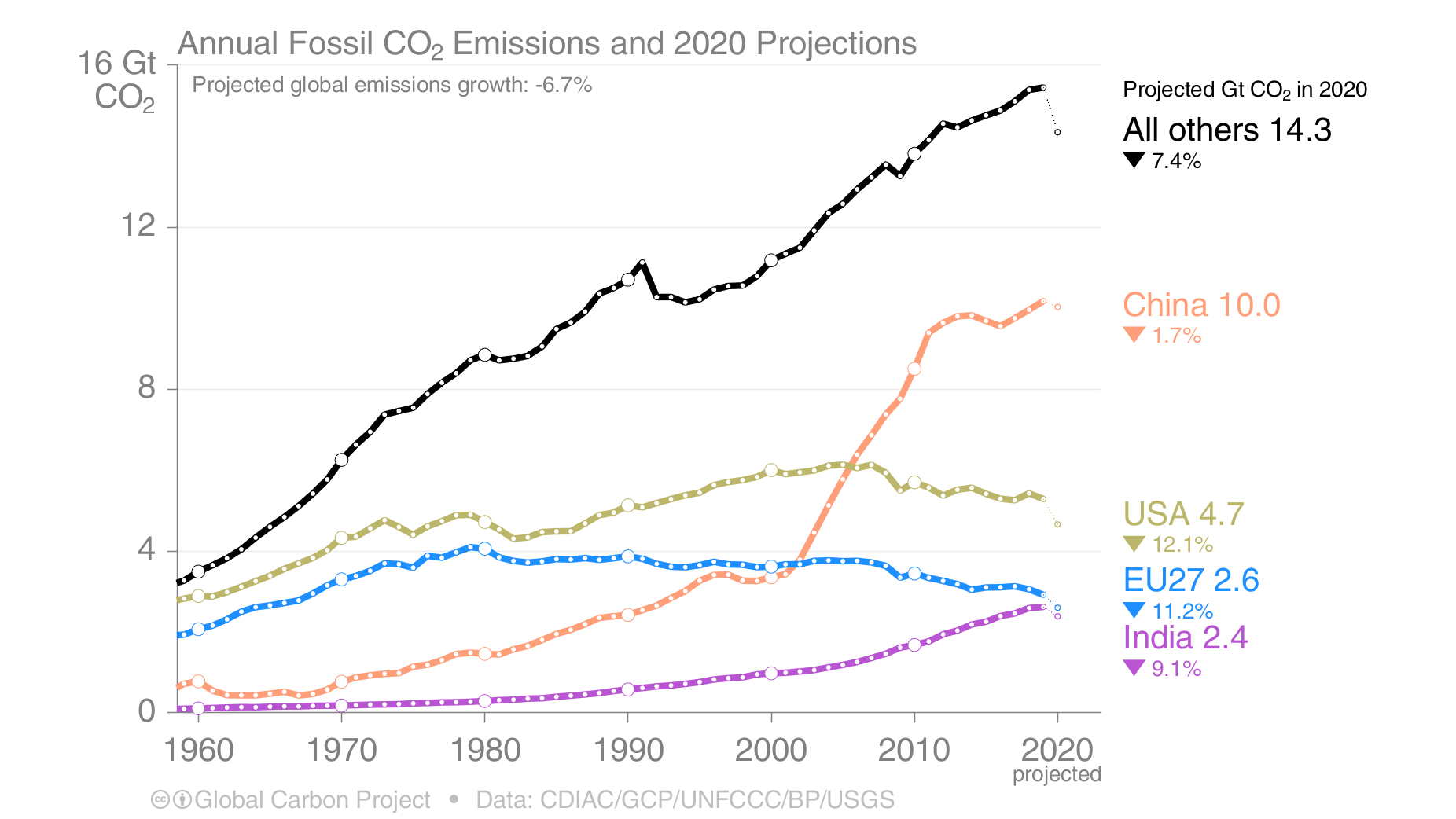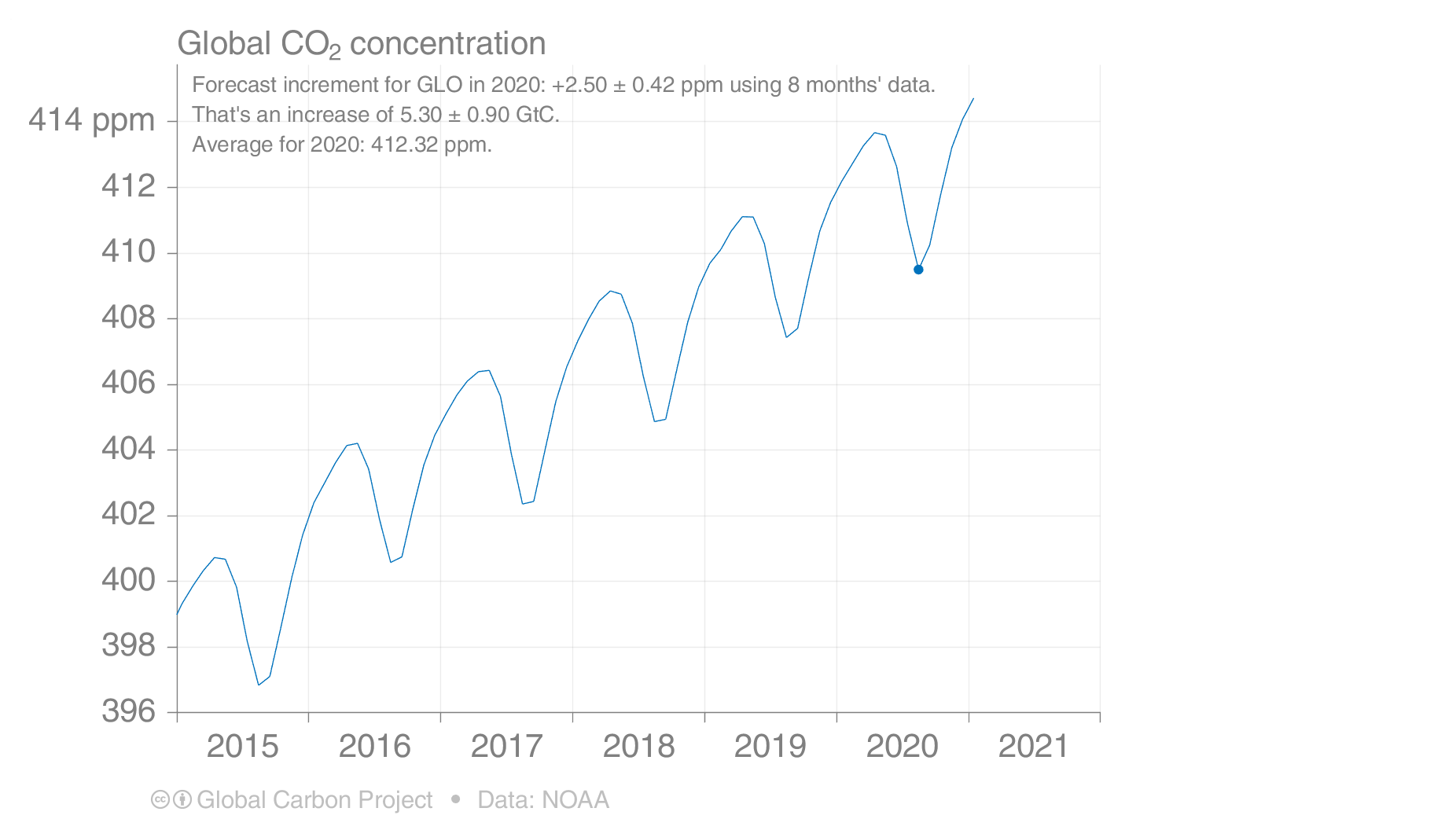Pandemic leads to decrease in global CO2 emissions
- D-USYS
- Institute of Biogeochemistry and Pollutant Dynamics
The new carbon budget of the Global Carbon Project shows an unprecedented decline in fossil CO2 emissions. The atmospheric CO2 concentration continues to rise.
The Global Carbon Project reports the decline in emissions during the coronavirus pandemic: fossil CO2 emissions fell by 7% on global average in 2020 (EU27: -11%, USA: -12%).
- The main driver of this development is the transport sector.
- However, there is no significant improvement in emissions from land use.
- Total CO2 emissions - from fossil CO2 and land use - will be around 39 GtCO2 in 2020.
According to the latest figures published by the Global Carbon Project (GCP), the current coronavirus pandemic has led to a significant reduction in global CO2 emissions. The GCP is an international collaboration of researchers, including the group of Nicolas Gruber at ETH Zürich. The GCP diagnoses every year the amount of CO2 that is being emitted into the atmosphere from the burning of fossil fuels and from land use change, and how much is being removed from the atmosphere by sinks on land and in the ocean.

The latest report issued by the GCP shows that, 5 years after the conclusion of the Paris Agreement, the rate of increase in global CO2 emissions has slowed. In the decade from 2010 to 2019, CO2 emissions from fossil sources decreased significantly in 24 countries whose economies had grown over the same period. This result suggests that policies intended to mitigate climate change may be having an effect.
Over the course of this year – in part owing to the measures introduced in response to the coronavirus pandemic – global emissions of fossil carbon are estimated to have fallen to 34 billion tons (34 Gt CO2). This figure represents a decrease of some 2.4 Gt from the previous year. This is a considerably larger drop than previous dips in the emission record for the years 1981 and 2009 (0.5 Gt), 1992 (0.7 Gt) and 1945 (0.9 Gt). In order to achieve the goals set out in the Paris Agreement, CO2 emissions must fall by between 1 and 2 Gt annually between now and 2030.
Researchers fear rebound effect
The decrease was particularly notable in the USA (-12%) and in member states of the EU (-11%). According to the researchers, this is a result of the combined effects stemming from reductions in the use of coal and from the restrictions imposed in response to the coronavirus pandemic. This strong reduction in emissions in 2020 enforces a trend that already began in 2019, when the emissions grew already considerably slower than in previous years. Is this already a sign of a trend change? Gruber argues: “I am skeptical. This depends strongly on the measures taken to stimulate the economy. Unless they are coupled to decarbonization, I am afraid that we will see a big rebound effect, and potentially even an overshoot. In fact, we are already seeing signs that the emission rate is climbing back toward the level observed for 2019.”
Transport sector accounts for most of the fall
Most of the decrease recorded for 2020 can be attributed to a drop in the carbon footprint of the transport sector. In December 2020, emissions due to road and air traffic still were about 10% and 40% below the 2019 values. The authors of the report emphasize that it is not yet possible to assess whether the rate of global emissions will continue to fall in the coming years. Following the decrease in emissions in the aftermath of the global financial crisis in 2008, emissions rebounded a massive 5% in 2010, as the global economy recovered. The fear is that this could happen also in 2021.
No significant decrease in emissions from land use change
The researchers investigated also the impact of changes in land use on the global carbon balance. While unusually high levels of emissions from these sources were estimated for 2019 – which were exacerbated by extraordinarily dry conditions in Indonesia and the highest rate of deforestation in the Amazon Basin since 2008 – the value for 2020 is lower again and equivalent to the mean level for the decade as a whole.
Continuing increase in atmospheric CO2
Overall, total emissions of CO2 – from fossil sources and land use – for 2020 are estimated to be on the order of 39 Gt, which approximately corresponds to the value recorded for the year 2012. This caused the CO2 concentration of the atmosphere to continue rising, and the average concentration for the current year is expected to set a new record of 412 ppm (parts per million). This corresponds to a rise of 48% relative to the pre-industrial level. The authors of the new report point out that the atmospheric CO2 level, and consequently the world’s climate, will only stabilize when global CO2 emissions are near zero.

The natural sinks continue, for the time being
Nicolas Gruber, together with his postdoc Luke Gregor, investigated the role of the ocean as a sink for anthropogenic CO2. To this end, they used numerical models of the ocean as well as observations that they interpreted with the help of machine learning techniques. The observations are not yet available for 2020, but the data for 2019 reveal that the ocean has taken up almost 10 GtCO2 in that year. The ocean thus removed 23% of the total emissions from the atmosphere. Gruber predicts: „We except a very similar uptake for 2020 as for 2019, since in 2020 neither an El Niño nor a La Niña were present in the Pacific.”
Also the land ecosystems took up a very substantial amount of anthropogenic CO2. In 2019, these systems removed about 11 GtCO2 from the atmosphere, which corresponds to about 27% of the total emissions. One expects a very similar uptake also for 2020.
Over the last few decades the land and ocean carbon sinks have increased substantially, largely in sync with the increase in atmospheric CO2. For 2020, the land and ocean have taken up about 54% of the total emissions. But Gruber emphasizes: “We cannot assume that these natural carbon sinks will continue into the future in the same way. This means that we need to increase our efforts to reduce the emissions of CO2. In order to reach the goals of the Paris agreement, we will have to repeat a similar level of reduction as we achieved this year through Corona for every year for the next 30 years.”
Further information
The team of 86 climate researchers from all parts of the world publishes its study in the peer-reviewed journal Earth System Science Data. The Global Carbon Budget 2020 is the 15th edition of the annual update that started in 2006. Besides Nicolas Gruber und Luke Gregor of ETH Zürich, Sebastian Lienert of the Oeschger Zentrum of University of Bern was involved from Switzerland.
- Friedlingstein P et al. (2020): Global Carbon Budget 2020. Earth System Scence. Data 12(4): 3269-3340, 11December 2020, doi: external page 10.5194/essd-12-3269-2020
- Data and Figures: external page http://www.globalcarbonproject.org/carbonbudget
- Data Atlas: external page http://www.globalcarbonatlas.org
- Estimated Daily Emission Rates: external page https://carbonmonitor.org/